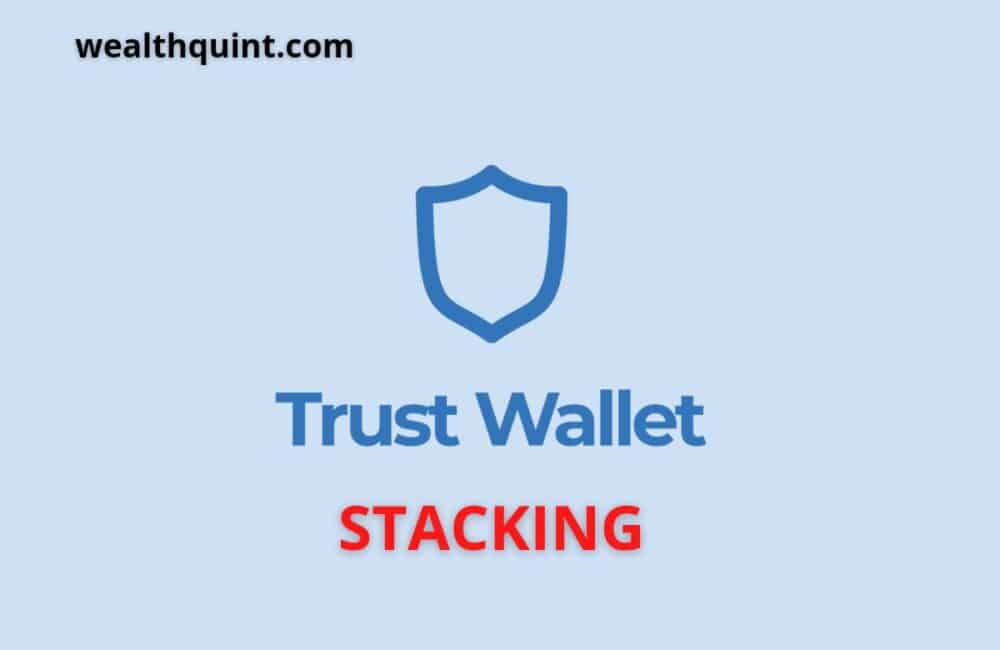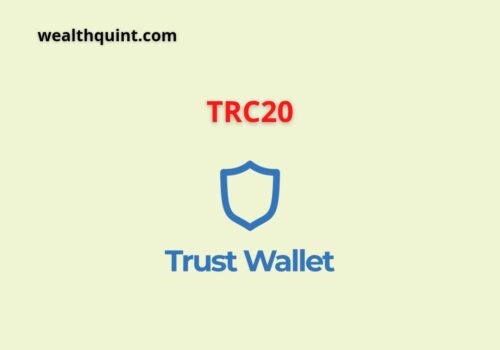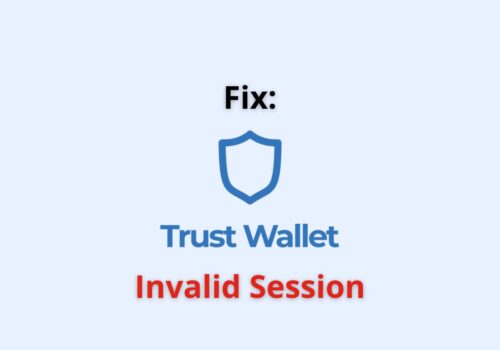It entails storing funds in a cryptocurrency wallet to maintain a blockchain network’s security and functioning. Staking, simply defined, is the act of securing cryptocurrency in order to obtain benefits.
You’ll be able to stake your coins straight from your crypto wallet, such as Trust Wallet, in the majority of circumstances.
Many exchanges, on the other hand, provide staking services to their users. Staking on is a straightforward way to earn rewards – all you have to do is keep your coins on the exchange. There will be more on this later.
To obtain a better understanding of what staking is, you should first learn how Proof of Stake (PoS) works.
What Is Staking?
Staking is a way to earn passive income from your coins without having to spend time or energy on them. If you want to start staking, you’ll need to choose a wallet that supports it.
There are several wallets out there that support staking, but they each have their pros and cons. Some are better suited for beginners, while others are designed specifically for experienced investors.
A good wallet should offer security features such as cold storage, hardware encryption, and two-factor authentication. The best ones also allow you to stake multiple coins at once.
What Is Staking In Trust Wallet?
Staking in Trust Wallet is a way to earn passive income from your coins without having to spend time or energy on them.
In blockchain transactions, you’re required to get them validated. For example, bitcoin involves mining or Proof-of-Work.
Other consensus mechanisms have been developed so far such as the Proof-of-Stake. This model has many variations and models and all are collectively known as staking.
Coin staking on Trust Wallet gives currency holders the power on decision making on the network. by staking coins, the user gets the opportunity to generate an income by voting.
This can be explained with the analogy of a bank system where you store your money in the bank for interest or give it to the bank to invest.
Is Staking Crypto Safe?
Staking Crypto is safe and carries many benefits. one is that you get guaranteed returns. Plus, you don’t need to continuously buy expensive hardware and spend on electricity as is required in the mining method.
But, then again, it has some associated risks as well. For example, lock-up periods, falling crypto rates, minimum holding requirements, etc.
Does Trust Wallet Support Staking?
Yes, Trust Wallet allows you to stake your crypto coins. you can use the two standard methods of either holding the coins in your wallet or by storing and locking them in a smart contract.
How Does Trust Wallet Staking Work?
Staking coins on the Trust Wallet is very simple. you can use the standard methods. One of them requires you to hold your crypto coins in your wallet. The other one involves you locking them up in a smart contract.
The process here is analogous to the lottery system where the lottery ticket numbers are equivalent to the number of coins you hold. you can also delegate in the Trust Wallet staking system where the individual is delegating their voting rights to earn interests for a trusted party.
These delegates then earn all the rewards via block validation and pay some dividends to their supporters in return for the vote.
What Is Native Staking?
Native Staking refers to staking or holding your crypto coins on the native platform such as Trust wallet instead of holding it on any external wallet or some other crypto exchange platform.
Native token staking options on Trust Wallet:
trust wallet allows you to stake the following crypto coins:
- Binance coin (BNB)
- Cosmos (ATOM)
- Callisto (CLO)
- IoTeX (IOTX)
- TRON (TRX)
- Terra (LUNA)
- Kava (KAVA)
- Algorand (ALGO)
- Tezos (XTZ)
- VeChain (VET)
- TomoChain (TOMO)
Is A Trust Wallet Good For Staking?
Yes. With Trust Wallet, you can earn bitcoin by staking from within the app while maintaining total control over your assets. BNB staking returns may be as high as 30% + APY, and Trust Wallet doesn’t take a cut.
Additionally, Staking may be a terrific method to earn passive money with your cryptocurrency, especially because certain cryptocurrencies pay out large interest rates for staking.
However, before you get started, you need to have a thorough understanding of how crypto staking works.
Is It Safe To Have A Trust Wallet?
Despite the fact that they are not as safe as hardware wallets, they are still a better solution for storing your crypto assets than a centralized exchange. Traders will be able to determine whether or not the Trust Wallet is a handy alternative for them at the conclusion of this assessment.
How To Stake An ETH On Trust Wallet?
Using Lido and Trust Wallet, Ethereum staking is made simple. To get started, follow the steps below:
- Open the Trust Wallet DApp browser and type Lido.fi into the address bar. You may also choose Lido Staking from the DApps list.
- To continue, tap on Stake. If your wallet does not connect immediately, touch on Connect wallet, agree to the Terms of Service, and then press on Trust.
- Your ETH balance will be displayed on the Stake Ether screen. Tap on Stake after entering the amount you wish to stake.
- By tapping on Send, you may confirm the transaction. Allow time for the transaction to be completed.
How To Stake Shiba Inu On Trust Wallet?
To begin, you must first place Shiba Inu tokens in your trust wallet.
Steps of Staking Shiba Inu on Trust Wallet:
Step 1. Open the Trust wallet app, create an account, or log in to your existing one.
Step 2. Click “Receive” and upload your address (public key). Note: Never share your private key with anyone!
Step 3. Now you can see all of your tokens that are associated with the public key just uploaded. Scroll down until you find your Shiba Inu tokens – they will be in the form of “SEND (amount of Shibas you want to stake) (public key)”
Step 4. Click on the token which has your public key on it and copy its address.
Step 5. Go to your MEW or METAMASK account where you currently hold your other tokens. Click “Send Ether & Tokens” and send the Shiba Inu tokens to your Trust wallet address
Step 6. You can verify that your tokens have arrived in your Trust wallet by navigating to the ‘Show All Tokens’ section of the application.
Step 7. Now you are ready to start staking!
Withdrawing Staked Tokens
Withdrawing staked tokens takes a long time and might take up to a week. To do so, we first link our wallet, and then select the Unstake option in the Burry option, in the section where we input the number of tokens for the STAKING procedure, to retrieve the number of tokens that we want to withdraw.
Trust Wallet Staking Rewards
The main advantage of staking is that you earn additional cryptocurrency, and interest rates may be quite high. You may be able to earn more than 10% or 20% every year in some instances. It has the potential to be an extremely rewarding investment. And all you’ll need is crypto that follows the proof-of-stake concept.
The following are some other advantages of staking cryptocurrency:
- It’s a simple method to make money from your bitcoin investments.
- Crypto staking does not require any special equipment, unlike crypto mining.
- You’re contributing to the blockchain’s security and efficiency.
- It is less harmful to the environment than crypto mining.
Trust Wallet Staking Rates
The best crypto staking coins are ones that pay out a high rate of return straight from the network. Validator payouts should be enforced with an automated method if you need to stake via a validator.
You won’t have to rely on the validators’ goodwill, and you won’t have to operate a whole node yourself. In terms of the Trust wallet staking rates, ETH2, ADA, DOT, NEO, and Tezos are the best crypto staking coins.
On the other hand, the Binance-owned Trust Wallet is the most popular staking wallet.
Conclusion
Trust wallet staking is an innovative feature, allowing users to stake their TRST tokens directly in Trust Wallet. Users are able to stake their TRST tokens in Trust Wallet.




